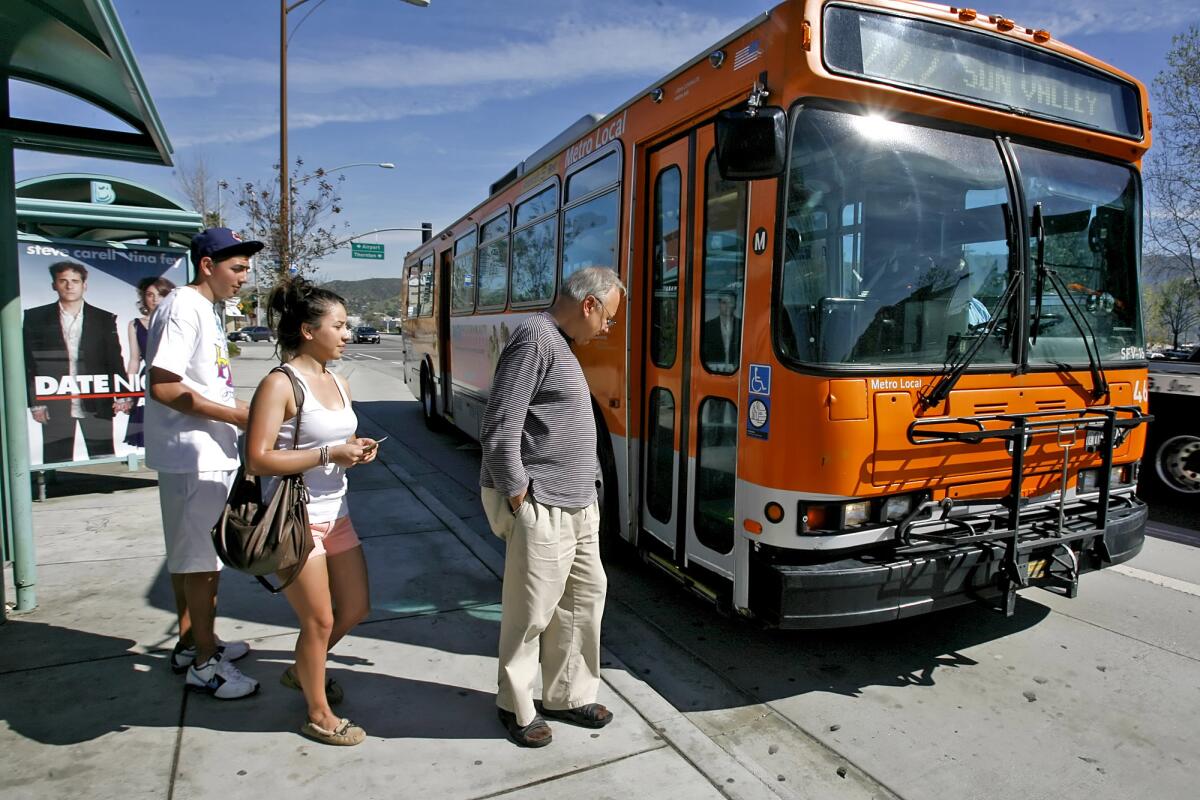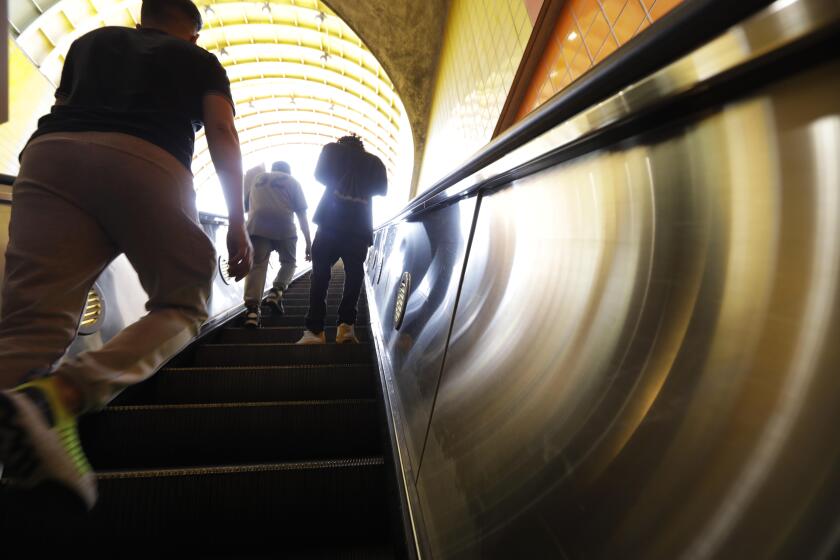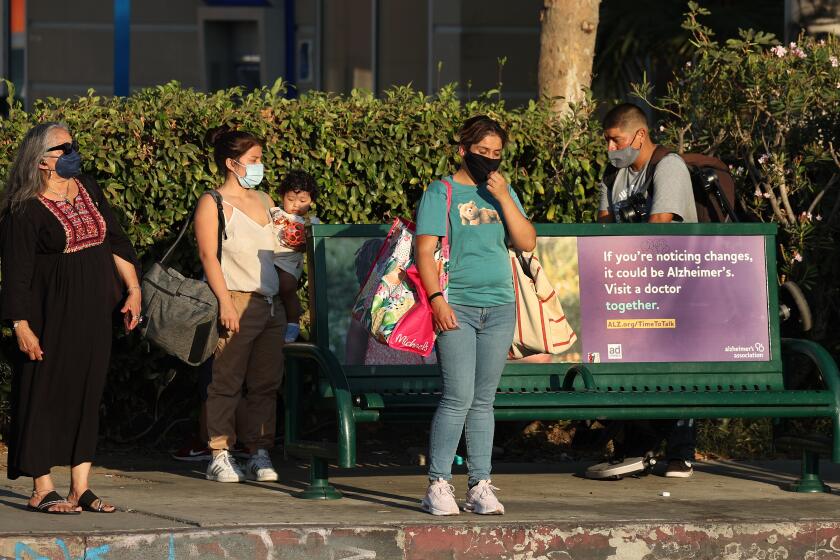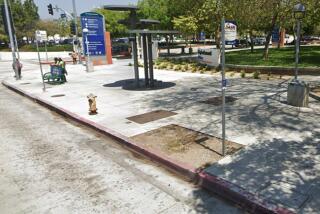Women’s ridership down on L.A. Metro, and satisfaction with buses, trains falls

Fewer women are riding buses and trains in Los Angeles County compared to three years ago, and satisfaction with the region’s public transportation system has also decreased, according to a recent survey.
In its first comprehensive survey since 2019, the Los Angeles Metropolitan Transportation Authority found safety was the top concern among the more than 12,000 bus and train riders polled this spring, followed closely by cleanliness, homelessness and timeliness.
“It’s really easy to do a survey and then put it in the filing cabinet and do nothing with it,” said Jennifer Vides, Metro’s chief customer experience officer. “That’s not what’s happening. We are looking at all of it, we are convening teams to talk about the results from the survey and to develop a customer experience plan that addresses these things.”
Although women made up the majority of bus riders in 2019 — at 53% — they accounted for only 49% of riders this year, according to the customer experience survey. The percent of women on Metro train lines also fell, though only by 2 percentage points, to 44%. Compared to all respondents, female riders were more likely to cite safety as the top issue on which they wanted Metro to make improvements.
Metro provides the bulk of public transportation service for Angelenos, with a fleet of more than 2,000 buses and six rail lines, which carry about 800,000 riders daily, according to the agency. It also supports a bike share and new ride-share program, but the survey focused primarily on bus and train riders.
Elizabeth Medrano, a bus rider since the 1990s and now a transit organizer with the nonprofit Women Organizing Resources, Knowledge and Services, said it’s hard to pinpoint one reason for decreased female ridership, but noted the pandemic is still affecting many women, who are struggling financially as they are unable to return to the jobs they held before the pandemic. And she noted that Metro’s bus service has still not returned to pre-2020 levels of service, making reliability and timeliness continued challenges — which can increase safety concerns.
“Safety, for me, is a feeling; it is real and also it expands,” Medrano said. “If I’m waiting for a long time, I’m not feeling safe.”
Can transit officials make buses and trains safer without more police? A new program will put 300 unarmed ambassadors as violence rises on the system.
Vides said the agency is close to getting all of its buses back on the road but noted a shortage of bus drivers has further delayed the agency’s progress. Metro officials and community leaders are also hopeful that the new transit ambassador pilot program — which is putting 300 uniformed and trained, yet unarmed, Metro staff on trains and buses — will improve safety by increasing the number of people at transit hubs and providing support to anyone who needs help.
Overall satisfaction of Metro services fell most significantly among bus riders, dropping from 67% riders reporting satisfaction in 2019 to 60% this year, according to the survey. Train riders’ satisfaction only dipped 1 percentage point, to 58%.
The survey also found consistent ridership also fell in the last three years, with only 78% of respondents saying they rode Metro at least three days a week — down from 89% in 2019. Consistency fell the most among train riders, almost 15 percentage points, according to the survey.
“The No. 1 goal for us is to improve the experience for customers,” Vides said. “The issues that they’re concerned about are the same ones that we’re concerned about. ... And so in a lot of ways, [the survey] sort of validated some of the work that we’re already doing.”
Beyond the new ambassador team, Vides said the agency is working to expand homeless outreach teams, implement a Gender Action Plan to make Metro more attractive and feasible for female riders and invest in safety infrastructure, like improving lighting and cameras.
The proportion of younger Metro users also dropped in recent years, with riders younger than 24 down about 7 percentage points from 2019 levels, according to the survey. Meanwhile, the share of riders between 25 and 64 grew, increasing about 6 percentage points since 2019, to almost 70% of riders.
Thousands of Metro bus stops have no shelter or even a seat. But a proposal to bring new shelters to Los Angeles with digital ads is raising doubts.
The racial and ethnic breakdown of riders did not change much since 2019: Those identifying as Hispanic and Latinx (the terms used in the study) continue to make up the largest group, at just under 60% of total riders. About 15% of riders are Black, followed by 12% who are white.
Oscar Zarate, the director of building equity and transit at Strategic Actions for a Just Economy, a nonprofit focused on economic justice in L.A., said he’s hopeful the survey results will be used to look for new solutions to these unsolved issues, like safety and homelessness, which have continued to plague Metro and affect ridership.
“We’ve tried criminalization, we’ve tried exclusion for so long and it hasn’t produced any results,” Zarate said. “Safety can look very different.”
Carmina Calderon, a senior organizer at the Community Power Collective, a group also advocating for economic justice based in East L.A., said she’s hopeful the ambassador program is a sign that Metro leaders are ready to keep improving transit in ways that will benefit those who rely on buses and trains, and not just scapegoat people who are unhoused or unable to pay fares.
“I want to say that I’m hopeful that they’ll address these concerns, but I think that the only way for them to actually come up with these changes is for them to consistently also ride the system that they represent, and to listen to the most marginalized people,” said Calderon, who’s been riding Metro since she was a child and recently helped advocate for Metro’s new ambassador program.
L.A. County Supervisor and Metro board member Holly Mitchell said the concerns made evident in the survey will drive future decisions about the agency.
“This year’s feedback from Metro riders reflects a candid assessment of where our agency needs to do better towards that vision,” Mitchell said. “We heard you and we are doing more to provide a safe, clean, and reliable environment for everyone.”
More to Read
Sign up for Essential California
The most important California stories and recommendations in your inbox every morning.
You may occasionally receive promotional content from the Los Angeles Times.













